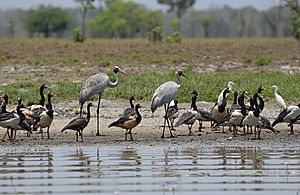Blue Mud Bay facts for kids
Blue Mud Bay is a large, shallow bay on the eastern coast of Arnhem Land in the Northern Territory of Australia. It faces Groote Eylandt in the Gulf of Carpentaria. The bay is about 580 kilometers (360 miles) east-south-east of Darwin. It is part of the Arnhem Coast region.
Blue Mud Bay is famous for a special court decision. This ruling confirmed that the Aboriginal traditional owners of much of the Northern Territory's coastline have special rights. These rights cover commercial and recreational fishing in the tidal waters over their land.
Contents
What is Blue Mud Bay Like?
The bay is about 90 kilometers (56 miles) long and up to 35 kilometers (22 miles) wide. Its wide opening is about 45 kilometers (28 miles) across. This opening stretches from Cape Shield in the north-east to Cape Barrow in the south-west, with Woodah Island in the middle.
The coastline of the bay is very diverse. It has many small bays, inlets, and islands. Along the edges, you'll find mudflats and mangrove forests. These areas blend into freshwater floodplains. The bay and its floodplains are owned by the Arnhem Land Aboriginal Land Trust. This means they are Aboriginal owned land.
People use the bay's waters for fishing. They especially catch mud crabs. The northern part of the bay is a Laynhapuy Indigenous Protected Area. There are plans to make this protected area even bigger.
Animals and Plants of Blue Mud Bay
Plants
Blue Mud Bay is home to some special plants. One plant, Triumfetta litticola, is found only in the Arnhem Coast region. The threatened Australian arenga palm (Arenga australasica) also grows here. In fact, 34 plant species found in the Northern Territory are unique to this area.
Birds
The coastal plains around the bay get flooded during certain seasons. Because of this, a group called BirdLife International has named it an Important Bird Area (IBA). This special area covers about 45,811 hectares (113,200 acres).
It is a very important place for many birds. Huge numbers of magpie geese (up to 500,000) live here. You can also find up to 40,000 wandering whistling-ducks and up to 3,000 brolgas.
Many other waterbirds also breed in large groups on the floodplain. These include egrets, herons, and spoonbills. The mudflats are also used by large groups of migratory waders (shorebirds) in the summer. Some of these shorebirds are black-tailed godwits, lesser sand plovers, and red-necked stints. The islands in the bay are important breeding spots for little, black-naped, and bridled terns.
Other Animals
The beaches of the larger islands in Blue Mud Bay are important. They are nesting places for flatback sea turtles. There is also a big group of little red flying foxes living in the mangroves at the northern end of the bay.
The threatened brush-tailed rabbit rat is found here. Douglas' skink (Glaphyromorphus douglasi) is a type of lizard found only in the Northern Territory. However, some animals like water buffalos and feral pigs, which were brought to Australia, can harm the wetlands.
The Blue Mud Bay Court Case
The "Blue Mud Bay case" was a very important court case. It was about who owned the fishing rights in the tidal waters over Aboriginal land at Blue Mud Bay. The case went all the way to the High Court of Australia. On July 23, 2008, the High Court made its final decision.
The High Court decided that the water over Aboriginal land should be treated the same as the land itself. In the Northern Territory, Aboriginal land usually extends to the low tide mark. This means that if you need permission to go onto Aboriginal land, you also need permission to go onto the water that covers that land.
This case was a big step because it was the first time that native title rights for Indigenous Australians were recognized over an intertidal zone (the area between high and low tide). The small Yolŋu community of Baniyala played a key role in winning this important case.
Fishing and Other Activities
In 2019, the people of Baniyala worked with the CSIRO. They wanted to find new ways to help their local economy. They looked into ideas like aquaculture (farming seafood, especially sea cucumbers), mining, forestry, eco-tourism, and guided fishing trips.
In July 2019, the Northern Land Council made an agreement with the Northern Territory Government. This agreement was about access to the waters for commercial and recreational fishing. However, they did this before talking to the traditional owners. After community leader Djambawa Marawili raised concerns, a meeting was held. On the 11th anniversary of the High Court's Blue Mud Bay decision, the traditional owners signed an agreement. This allowed fishing access to these waters for the next 18 months.
In July 2020, the Northern Land Council and the Northern Territory Government signed the "Blue Mud Bay Action Plan". Both groups promised to make sure Indigenous people in the region have fishing rights. This plan is part of a bigger agreement called the Nitmiluk Agreement. It aims to create economic chances for Aboriginal people in the fishing industry, including starting an Aboriginal-owned fishing business.
Garrangali Band
The Garrangali Band comes from the small community of Baniyala on Blue Mud Bay. In their 2020 song "One Voice", they sing about life in their region. Mudiny Guyula, the band's lead singer, said the song is about bringing people "back to their promised land, their homeland, so we can recognise who we are".


